With rains washing out our plans of touring the national parks south of Mysore and the Kodagu (Coorg) Hills, we decided to head north to the ruins of Hampi where we hoped the rains wouldn’t follow us. However, the only bus out of Mysore to Hospet (closest large town from Hampi) was an ordinary KSTDC one, which left at 8pm and arrived at 6am the following morning; no luxury buses ran on that route. We were bummed! Sitting in straight-backed, ordinary seats with our backpacks crowded at our feet all through the night, seemed quite impossible. In the end we found an overnight, air-conditioned Volvo bus from Mysore, which got us to Bellary (via Bangalore) the following morning. From Bellary we took an ordinary state bus at around 6:30am and got to Hospet a couple of hours later. But we weren’t done yet! From Hospet we took an auto to Hampi, which is some 13kms NE. So after about 13hrs of journeying we finally got to our destination only to find that rains had preceded us there!
In the rain it was difficult to hunt for a place to stay. So I parked myself with the bags in a cafe, while Madhu went around looking for accommodation. We decided to stay in the village of Hampi as, apart from providing a convenient base to explore the ruins, it is where most of the action (restaurants, stores and fellow-travelers) is. However, finding a decent place to stay in an area that caters mainly to budget-conscious backpackers wasn’t easy. After nearly 45minutes of looking around, Madhu finally found a recently renovated guesthouse, where we could check in for 3 nights.
Thankfully, the rains lasted only for a day. We used that day to relax in our guesthouse, watch TV and catch up on lost sleep. We couldn’t step out a whole lot except for food as the village streets were slushy and yucky with cow dung mixed in liberally with unpaved street dirt. We tiptoed our way around and prayed for the rains to end. Our prayers were answered with a gloriously sunny morning the following day; excitedly we stepped out for our first look at legendary Hampi!
Bordered by the lovely Tungabhadra River on the north, Hampi has had a glorious past as the capital of the mighty Vijaynagara Empire, which lasted for nearly 200 years beginning in the 14th century AD. Then known as Vijayanagara, 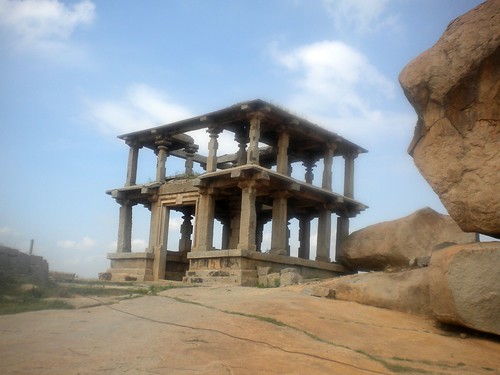 most of Hampi’s fabulous temples were built during the reign of Krishnadevaraya in the 16th century. However, apart from just architecture, what attracts thousands of tourists to this village is its spectacular landscape! Millions of years of erosion have caused the formation of large, spherical boulders that are strewn all over the place. They look almost unreal and quite unlike anything anywhere else in the country. In fact, Hampi is recognized world-wide by the ruins of the Vijayanagara Empire framed beautifully against a boulder-strewn background!
most of Hampi’s fabulous temples were built during the reign of Krishnadevaraya in the 16th century. However, apart from just architecture, what attracts thousands of tourists to this village is its spectacular landscape! Millions of years of erosion have caused the formation of large, spherical boulders that are strewn all over the place. They look almost unreal and quite unlike anything anywhere else in the country. In fact, Hampi is recognized world-wide by the ruins of the Vijayanagara Empire framed beautifully against a boulder-strewn background!
The major ruins are spread around 2 separate areas. One is known as the ‘Sacred Center‘ as the ruins are spread around the 16th century, Virupaksha Temple dedicated to Lord Shiva. It’s located in the heart of Hampi village. The other, known as the ‘Royal Center‘ has ruins of palaces and royal parade grounds and is located some 3kms south of Hampi village. We started our exploration by visiting two spectacular temple complexes east of the Sacred Center: the Achyutaraya Temple complex and the Vittala Temple complex.
All traffic heading into Hampi village ends in front of the Virupaksha Temple, which sits at the western-most end of Hampi’s main market street. From here we walked to its eastern-most end, which is just about 200m away. There are slums on either side of the road interspersed with food and handicraft stalls. Cows and bulls wander the streets aimlessly dirtying them along with children who squat by the sides; it was a sad sight! Parts of the street have colonnaded galleries on either side, some of which have been taken over by the slum-dwellers while the rest are in ruins. At the end of the street is a large monolithic statue of Nandi Bull, seated inside a four-pillared pavilion. To its right, steps lead up into the hillside and eventually led us through large boulders and cacti bushes to the fabulous Achyutraya Temple complex.
Built in 1534, this gorgeous temple complex is a little bit in ruins today but stands out beautifully amidst the rocky landscape. We entered it through i ts western entrance but the main entrance, which has a beautiful Gopuram, lay to the north. In fact, the complex has two identical Gopurams in the north, both attached to a Prakara (pillared boundary wall enclosing the main shrine). Just inside the first Prakara to the right is a beautiful, 100-pillared hall, with a few missing pillars. Inside the 2nd Prakara we were faced by an open Mandapa that is attached to the front of the main shrine. It had exquisite carvings, which were much finer than the ones in the 100-pillar hall. Sadly, the idols from the main shrine as well as the smaller, Lakshmi shrine were missing.
ts western entrance but the main entrance, which has a beautiful Gopuram, lay to the north. In fact, the complex has two identical Gopurams in the north, both attached to a Prakara (pillared boundary wall enclosing the main shrine). Just inside the first Prakara to the right is a beautiful, 100-pillared hall, with a few missing pillars. Inside the 2nd Prakara we were faced by an open Mandapa that is attached to the front of the main shrine. It had exquisite carvings, which were much finer than the ones in the 100-pillar hall. Sadly, the idols from the main shrine as well as the smaller, Lakshmi shrine were missing.
Behind the southern wall of the complex is an image of Goddess Kali, carved into a large granite block. This image is worshipped by the  local population and has been painted over in bright colors.
local population and has been painted over in bright colors.
Exiting from the main Gopuram in the north, we entered a broad, stone-paved avenue, which had pillared pavilions on either side. The guidebooks referred to this as Sule bazaar, indicating that the pavilions were used to house shops outside the temple complex. It’s a beautiful avenue with an even prettier Pushkarani (holy water tank), at the other end. We sat by the edge of it for a while and marveled at a beautiful pavilion in the middle of the water; it was gorgeous!
Beyond the tank, the avenue hit a T-junction where the path to the right led to the Vitthala temple complex, while the one to the left led back to Hampi bazaar. We turned right. Along the way, there were several Mandapas and little shrines in ruins, giving the place a very derelict look. The path wound past the banks of the Tungabhadra and gave us a wonderful view of the snaking river.
The entry to Vitthala Temple complex is thru a double-storied gateway. Just inside, a structure to its left is known as the ‘King’s balance’ as it is where the royal family had themselves weighed in gold and precious stones, which was then distributed to the Brahmins of the temple – nice! At the eastern entrance to the walled enclosure of the main shrine, we bought tickets worth Rs.10 each (one of only two sites in Hampi that is ticketed). Inside the complex we were immediately struck by the fantastic architecture before us.
Built between the late 15th to early 16th century AD, the Vitthala Temple complex is considered to be the 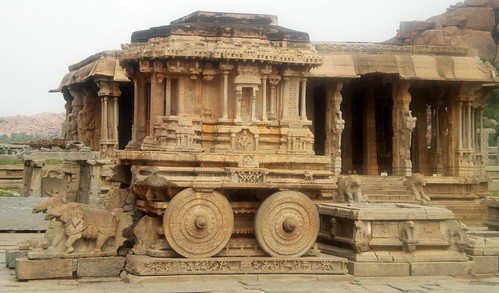 masterpiece of Vijayanagara architecture. In the middle of the courtyard, right in front of us was a free-standing stone chariot, which is definitely the highlight of the place. Apart from boulders, it is this piece of art that is most recognized in photographs representing Hampi. It is actually a shrine for Garuda, Lord Vishnu’s vehicle. Behind it and on either side were beautiful mandapas with the most gorgeous pillars ever! The one behind is attached to the main shrine and this is dedicated to Vitthala, a form of Lord Vishnu. Just as in the Acyutraya temple, no idol exists in the shrine here today!
masterpiece of Vijayanagara architecture. In the middle of the courtyard, right in front of us was a free-standing stone chariot, which is definitely the highlight of the place. Apart from boulders, it is this piece of art that is most recognized in photographs representing Hampi. It is actually a shrine for Garuda, Lord Vishnu’s vehicle. Behind it and on either side were beautiful mandapas with the most gorgeous pillars ever! The one behind is attached to the main shrine and this is dedicated to Vitthala, a form of Lord Vishnu. Just as in the Acyutraya temple, no idol exists in the shrine here today!
Exiting the temple complex, we retraced our steps back to the junction where the avenue from Achyutraya temple meets the main trail to Vitthala. Beyond this junction, a few meters ahead, is the temple dedicated to Kodandarama; it is right by the banks of the Tungabhadra River. Unfortunately, the temple is in use today because of which its exteriors have been repainted, completely washing out the carvings on the pillars in the porch. The ghat in front of the temple is called Chakratirth and is considered to be a sacred place to take a dip.
Beyond the pillared mandapa to the left of the temple, a narrow path sheltered under huge boulders, took us to a dirt trail that eventually led us back to Hampi’s main market street. We had completed a neat circle around Hampi bazaar’s eastern end!
In the evening we walked to the Virupaksha temple entrance and instead of entering it, took a left where stone steps led us up the Hemakuta Hill and to the fabulous temples and Mandapas atop it. A gateway to the right of the steps led us to the shrines. But we were here mainly for the sunset, which can be seen clearly from the western end of the hill. In fact, the tourism dept has setup a brand new ‘Sunset Point’ board behind the two-storied gateway that sits at the very top of the hill. Unfortunately, even though we got there in time for sunset, the sun hid behind large clouds as it made an exit for the day. We spent the next half hour just enjoying the lovely views around us and didn’t bother checking out the temples.
The following morning, we started our day by paying a visit to 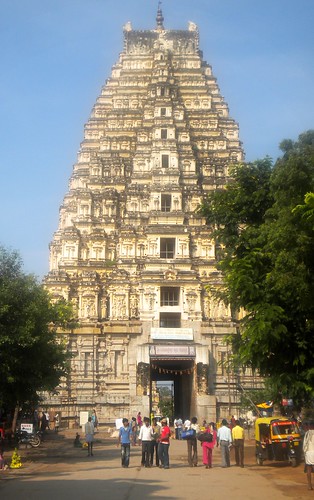 the Virupaksha Temple complex. Its grand, 50m high, Gopuram marks the western end of Hampi’s market street. It can be viewed from almost anywhere in Hampi and looks spectacular as it rises above the village. Beyond the Gopuram is a large square with living quarters on two sides and another, albeit smaller, Gopuram in the front. In the evenings, if it’s not too crowded, this square is a nice place to sit in and enjoy the village atmosphere. Beyond the second Gopuram is the main shrine, which, typical of Vijayanagara architecture, has a pillared mandapa attached to its front. The pillars are beautiful but the unique feature of this temple is the painted ceiling of the mandapa. It had scenes depicting marriage processions and Shiva in a chariot killing a demon. The painting is said to belong to the 19th century and could have been repainted over an original 16th century one, which was when the complex was built.
the Virupaksha Temple complex. Its grand, 50m high, Gopuram marks the western end of Hampi’s market street. It can be viewed from almost anywhere in Hampi and looks spectacular as it rises above the village. Beyond the Gopuram is a large square with living quarters on two sides and another, albeit smaller, Gopuram in the front. In the evenings, if it’s not too crowded, this square is a nice place to sit in and enjoy the village atmosphere. Beyond the second Gopuram is the main shrine, which, typical of Vijayanagara architecture, has a pillared mandapa attached to its front. The pillars are beautiful but the unique feature of this temple is the painted ceiling of the mandapa. It had scenes depicting marriage processions and Shiva in a chariot killing a demon. The painting is said to belong to the 19th century and could have been repainted over an original 16th century one, which was when the complex was built.
Apart from the main shrine dedicated to Virupaksha (a form of Lord Shiva), there are several smaller shrines dedicated to Goddesses Parvati and Bhuvaneshwari, and to Lord Vishnu. However, the highlight of our visit was meeting a beautiful calf that was being raised by the temple priests. He was unbelievably adorable and other than being fed, loved being petted.
A large, 16th century water tank, called the Manmatha Tank, sits outside the temple complex’s northern wall. We wandered out to it but found the place to be quite badly maintained with overgrown weeds around the tank and trash in the sacred water.
After exiting the temple, we decided to head back up the Hemakuta Hill as we hadn’t really explored any of the temple shrines atop it. However, to our utter disgust, as we walked up the steps that led off from the right of the temple, we found that there was poop all over the place. The place was stinking as hell! It looked (and smelled) like a large group of people had taken a collective dump at the place; downright disgusting! We couldn’t believe that people could do this right outside a temple complex! Moreover, as a World Heritage Site, shouldn’t these places be guarded and protected more effectively?!! Can’t wait to write a letter to the Archaeological Society of India with a piece of my mind!
We abandoned plans of visiting the Hemakuta Hill temples and walked towards another set of monuments that lay along the road to Hospet. This 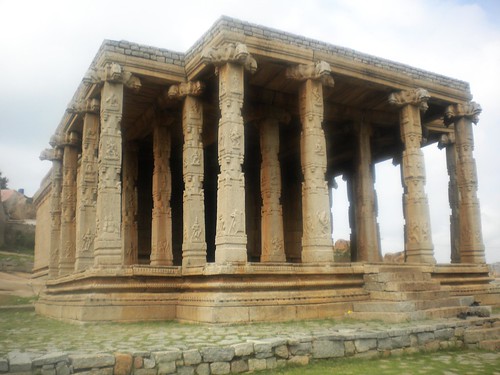 included two shrines dedicated to Ganapathi, called Kadlekalu Ganesha and Sasivekalu Ganesha. Both have monolithic statues of the Lord, which are quite spectacular. The former is about 4.5m tall while the latter is 2.4m. While the Kadlekalu Ganesha image is enshrined in a lovely temple with a pillared mandapa in the front, the Sasivekalu Ganesha is seated inside a simple pavilion, with beautifully manicured lawns all around. While taking pictures here, we noticed that steps led up the hill to the same two-storied gateway atop Hemakuta Hill where the Sunset Point board is! Thrilled at finding another way to get to the hilltop shrines without having to step through the filth near the temple complex, we hurried up the steps!
included two shrines dedicated to Ganapathi, called Kadlekalu Ganesha and Sasivekalu Ganesha. Both have monolithic statues of the Lord, which are quite spectacular. The former is about 4.5m tall while the latter is 2.4m. While the Kadlekalu Ganesha image is enshrined in a lovely temple with a pillared mandapa in the front, the Sasivekalu Ganesha is seated inside a simple pavilion, with beautifully manicured lawns all around. While taking pictures here, we noticed that steps led up the hill to the same two-storied gateway atop Hemakuta Hill where the Sunset Point board is! Thrilled at finding another way to get to the hilltop shrines without having to step through the filth near the temple complex, we hurried up the steps!
The shrines atop Hemakuta Hill are some of Vijayanagara’s earliest monuments. They belong to the 13th and 14th century, and are located on a sloping part of the hill, overlooking the village at the base. Here the pillars are not as ornate as those in the bigger temple complexes nor are the shrines as elaborate. But they are simple and elegant in design with pyramidal towers on the top. Some of them have 2 or 3 shrines on the same platform, with each opening out to a common mandapa in the center. All of them sit atop high stone platforms which are largely unadorned.
The last monument that we visited within Hampi’s Sacred Center is the large Krishna Temple complex, which lies just beyond 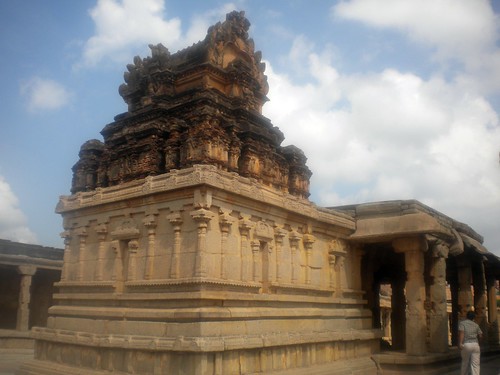 the Ganesha temples on the road leading south to the Royal Center and then on to Kamalapuram. Built in 1515 AD by King Krishnadevaraya to commemorate his victory over the rulers of Orissa, the temple was built to accommodate a granite icon of young Krishna, which was looted from the fort of Udayagiri (in Andhra Pradesh today). This icon is now safely ensconced in the State Museum of Chennai! The entrance Gopuram of the complex is quite spectacular and so are the Mandapas and shrines within. The plan is exactly similar to that of the other temple complexes.
the Ganesha temples on the road leading south to the Royal Center and then on to Kamalapuram. Built in 1515 AD by King Krishnadevaraya to commemorate his victory over the rulers of Orissa, the temple was built to accommodate a granite icon of young Krishna, which was looted from the fort of Udayagiri (in Andhra Pradesh today). This icon is now safely ensconced in the State Museum of Chennai! The entrance Gopuram of the complex is quite spectacular and so are the Mandapas and shrines within. The plan is exactly similar to that of the other temple complexes.
An unpaved road, a few meters further south of the temple, leads to a large 6.7m tall, monolithic image of Narasimha (an avatar of Lord Vishnu), seated under the shade of a snake hood. Commissioned in 1528 by Krishnadevaraya, the image is called Lakshmi Narasimha as it originally had a smaller image of Lakshmi, Narasimha’s consort, seated beside him. Unfortunately, that image is completely missing today; just the remnants of an arm around Narasimha, points to its existence. Right next to this structure, separated by a narrow channel of water, is a 3m tall, monolithic Shiva Lingam.
This exhaustive list of monuments completed our tour of the Sacred Center. Unbelievably there’s the whole of Hampi’s Royal Center still left to be explored¦
Additional Pictures : Hampi


No comments yet.